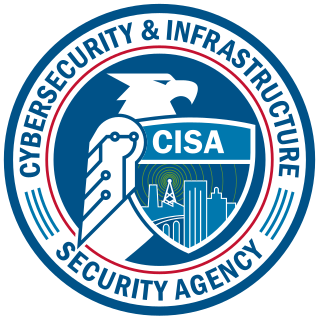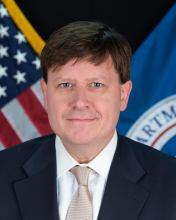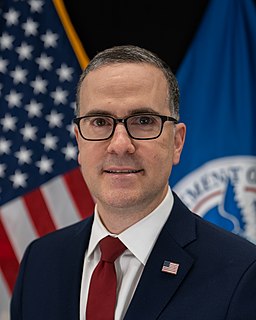
The National Communications System (NCS) was an office within the United States Department of Homeland Security charged with enabling national security and emergency preparedness communications using the national telecommunications system. The NCS was disbanded by Executive Order 13618 on July 6, 2012.

The United States Department of Homeland Security (DHS) is the U.S. federal executive department responsible for public security, roughly comparable to the interior or home ministries of other countries. Its stated missions involve anti-terrorism, border security, immigration and customs, cyber security, and disaster prevention and management.

The United States secretary of homeland security is the head of the United States Department of Homeland Security, the federal department tasked with ensuring public safety in the United States. The secretary is a member of the Cabinet of the United States. The position was created by the Homeland Security Act following the attacks of September 11, 2001.
The United States Computer Emergency Readiness Team (US-CERT) is an organization within the Department of Homeland Security’s (DHS) Cybersecurity and Infrastructure Security Agency (CISA). Specifically, US-CERT is a branch of the Office of Cybersecurity and Communications' (CS&C) National Cybersecurity and Communications Integration Center (NCCIC).

The National Cyber Security Division (NCSD) is a division of the Office of Cyber Security & Communications, within the United States Department of Homeland Security's Cybersecurity and Infrastructure Security Agency. Formed from the Critical Infrastructure Assurance Office, the National Infrastructure Protection Center, the Federal Computer Incident Response Center, and the National Communications System, NCSD opened on June 6, 2003. The NCSD mission is to collaborate with the private sector, government, military, and intelligence stakeholders to conduct risk assessments and mitigate vulnerabilities and threats to information technology assets and activities affecting the operation of the civilian government and private sector critical cyber infrastructures. NCSD also provides cyber threat and vulnerability analysis, early warning, and incident response assistance for public and private sector constituents. NCSD carries out the majority of DHS’ responsibilities under the Comprehensive National Cybersecurity Initiative. The FY 2011 budget request for NCSD is $378.744 million and includes 342 federal positions. The current director of the NCSD is John Streufert, former chief information security officer (CISO) for the United States Department of State, who assumed the position in January 2012.

The Homeland Security Act (HSA) of 2002, was introduced in the aftermath of the September 11 attacks and subsequent mailings of anthrax spores. The HSA was cosponsored by 118 members of Congress. The act passed the U.S. Senate by a vote of 90–9, with one Senator not voting. It was signed into law by President George W. Bush in November 2002.
An information assurance vulnerability alert (IAVA) is an announcement of a computer application software or operating system vulnerability notification in the form of alerts, bulletins, and technical advisories identified by US-CERT, https://www.us-cert.gov/ US-CERT is managed by National Cybersecurity and Communications Integration Center (NCCIC), which is part of Cybersecurity and Infrastructure Security Agency (CISA), within the U.S. Department of Homeland Security (DHS). CISA, which includes the National Cybersecurity and Communications Integration Center (NCCIC) realigned its organizational structure in 2017, integrating like functions previously performed independently by the U.S. Computer Emergency Readiness Team (US-CERT) and the Industrial Control Systems Cyber Emergency Response Team (ICS-CERT). These selected vulnerabilities are the mandated baseline, or minimum configuration of all hosts residing on the GIG. US-CERT analyzes each vulnerability and determines if it is necessary or beneficial to the Department of Defense to release it as an IAVA. Implementation of IAVA policy will help ensure that DoD Components take appropriate mitigating actions against vulnerabilities to avoid serious compromises to DoD computer system assets that would potentially degrade mission performance.
Phil Reitinger was the Deputy Under Secretary of the National Protection and Programs Directorate (NPPD) and Director of the National Cybersecurity Center (NCSC) at the United States Department of Homeland Security from 2009 to 2011. During that time, Reitinger led the department's integrated efforts to reduce risks across physical and cyber infrastructures and helping secure federal networks and systems by collecting, analyzing, integrating and sharing information among interagency partners.

The Under Secretary of Homeland Security for Intelligence and Analysis is a high-level civilian official in the United States Department of Homeland Security. The Under Secretary, as head of the Office of Intelligence and Analysis at DHS, is the principal staff assistant and adviser to the Secretary of Homeland Security and the Deputy Secretary of Homeland Security for fusing law enforcement and intelligence information relating to terrorism and other critical threats.

The National Cybersecurity and Critical Infrastructure Protection Act of 2013 is a bill that would amend the Homeland Security Act of 2002 to require the Secretary of the Department of Homeland Security (DHS) to conduct cybersecurity activities on behalf of the federal government and would codify the role of DHS in preventing and responding to cybersecurity incidents involving the Information Technology (IT) systems of federal civilian agencies and critical infrastructure in the United States.

Brigadier General Alicia A. Tate-Nadeau is a senior officer in the United States Army National Guard and the first woman to be promoted to brigadier general in the Illinois Army National Guard. She currently serves as the Director of the Illinois Emergency Management Agency.
The National Cybersecurity and Communications Integration Center (NCCIC) is part of the Cybersecurity Division of the Cybersecurity and Infrastructure Security Agency, an agency of the U.S. Department of Homeland Security. It acts to coordinate various aspects of the U.S. federal government's cybersecurity and cyberattack mitigation efforts through cooperation with civilian agencies, infrastructure operators, state and local governments, and international partners.
Dr. Phyllis Schneck is an American executive and cybersecurity professional. As of May 2017, she became the managing director at Promontory Financial Group. Schneck served in the Obama administration as Deputy Under Secretary for Cybersecurity and Communications for the National Protection and Programs Directorate (NPPD), at the Department of Homeland Security.

The Cybersecurity and Infrastructure Security Agency (CISA) is a United States federal agency, an operational component under Department of Homeland Security (DHS) oversight. Its activities are a continuation of the National Protection and Programs Directorate (NPPD). CISA was established on November 16, 2018 when President Donald Trump signed into law the Cybersecurity and Infrastructure Security Agency Act of 2018. Brandon Wales served as Acting Director until Jen Easterly was unanimously confirmed by the Senate on July 12, 2021 and became Director.

Matthew Travis is a businessman and former American government official. He served as the Deputy Director for the Department of Homeland Security's Cybersecurity and Infrastructure Security Agency (CISA). Mr. Travis served as Deputy Under Secretary for the National Protection and Programs Directorate (NPPD) before the agency became CISA on November 16, 2018.

Christopher Cox Krebs is an American attorney who served as Director of the Cybersecurity and Infrastructure Security Agency in the United States Department of Homeland Security from November 2018 until November 17, 2020 when President Donald Trump fired Krebs for contradicting Trump's claims of election fraud in the 2020 presidential election.

Brandon D. Wales is an American national security official who served as the acting director of the Cybersecurity and Infrastructure Security Agency. Wales assumed office after President Donald Trump fired Chris Krebs, and previously served as first executive director of the agency.

Jen Easterly is an American intelligence and former military official who is serving as the director of the Cybersecurity and Infrastructure Security Agency in the Biden administration. She was confirmed by a voice vote in the Senate on July 12, 2021.
National Initiative for Cybersecurity Careers and Studies (NICCS) is an online training initiative and portal built as per the National Initiative for Cybersecurity Education framework. This is a federal cybersecurity training subcomponent, operated and maintained by Cybersecurity and Infrastructure Security Agency.
Operational collaboration is a cyber resilience framework that leverages public-private partnerships to reduce the risk of cyber threats and the impact of cyberattacks on United States cyberspace. This operational collaboration framework for cyber is similar to the Federal Emergency Management Agency (FEMA)'s National Preparedness System which is used to coordinate responses to natural disasters, terrorism, chemical and biological events in the physical world.















